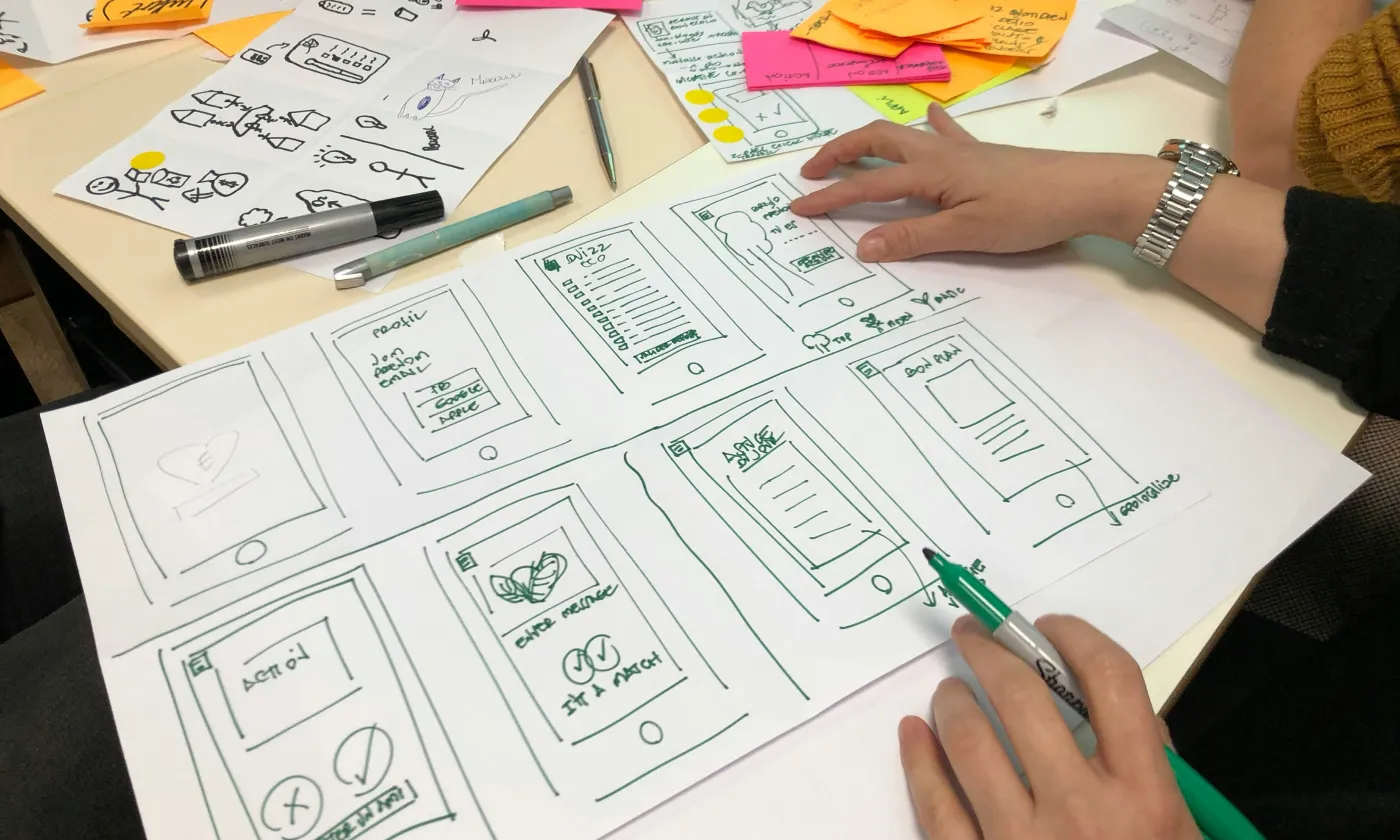
Every product is developed with a dual purpose: to provide value to its creator and to offer value to the end-user.
At Stfalcon, we take our clients on a guided journey throughout the project, constantly delivering value at each stage and maintaining effective communication. Our approach to the project development process begins with the crucial Discovery phase services for product development, ensuring the product’s success from the ground up.
The process of project development offers a structured approach to deconstructing projects into a series of more achievable tasks. This method empowers specialists to maintain control over the project and ensure the quality of the outcomes.
Project Workflow of Product Development
Blending creative elements with strategic tasks presents an exhilarating yet demanding venture. To guide through every stage towards the ultimate product launch, there exists a comprehensive plan for the product development workflow. Our project workflow is organized as follows:
- Daily Team Stand-ups: We conduct daily team stand-up meetings to ensure clear communication and alignment within the team.
- Weekly Client Meetings: We hold weekly meetings with our clients to provide updates on the project's progress and gather their feedback.
- Two-Week Iterations: Our work is organized into two-week iterations, allowing us to focus on specific tasks and deliverables within defined timeframes.
- Iteration Completion: At the end of each iteration, we present a demonstration of the completed functionality to the client, ensuring transparency and validation of our progress.
Methodology
The Scrumban methodology combines the best features of Scrum and Kanban into a hybrid project management framework. It uses Scrum's stable structure of sprints, standups, and retrospectives. Then it adds Kanban's visual workflow and work in progress limitations. The result is a truly flexible method for managing projects of any size.
Communication
All changes are documented by the Project Manager and require written approval from the client.
Communication channels include email, Google Meet, Slack, or any other channel preferred by the client for effective and clear communication.
This structured workflow and methodology ensure efficient project management and effective collaboration throughout the project development process.
Want a web app that does more?
Let's build a solution that's smart, sleek, and powerful.
Alina
Client Manager

How the Discovery Phase Enhances Efficient of Project Development Process
The Discovery phase is an information-gathering process that involves delving deeply into the industry, your business, and the target audience. This phase is essential for gaining a profound understanding of stakeholder expectations for the product and what end-users anticipate.
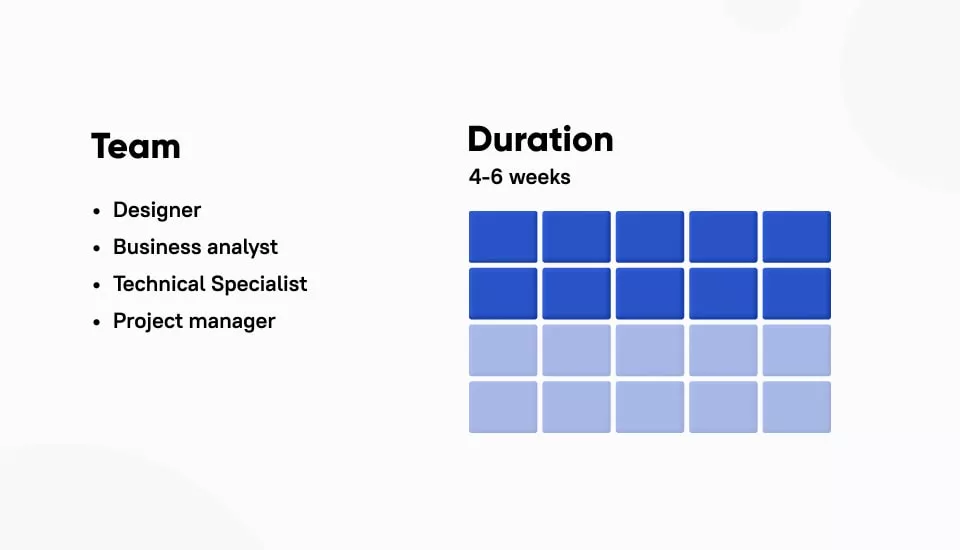
A comprehensive Discovery phase necessitates the involvement of a team comprising an experienced Project Manager (PM), a business analyst, a UI/UX specialist, and a technical consultant.
The PM is typically present throughout the Discovery stage, facilitating communication with the client and generating proposals. The designer is responsible for developing the UI/UX in the Discovery phase. The business analyst examines requirements and documentation preparation, making them an integral part of the project from start to finish.
Technical specialist participates during the evaluation and prototyping stages.
Components of the Discovery Phase
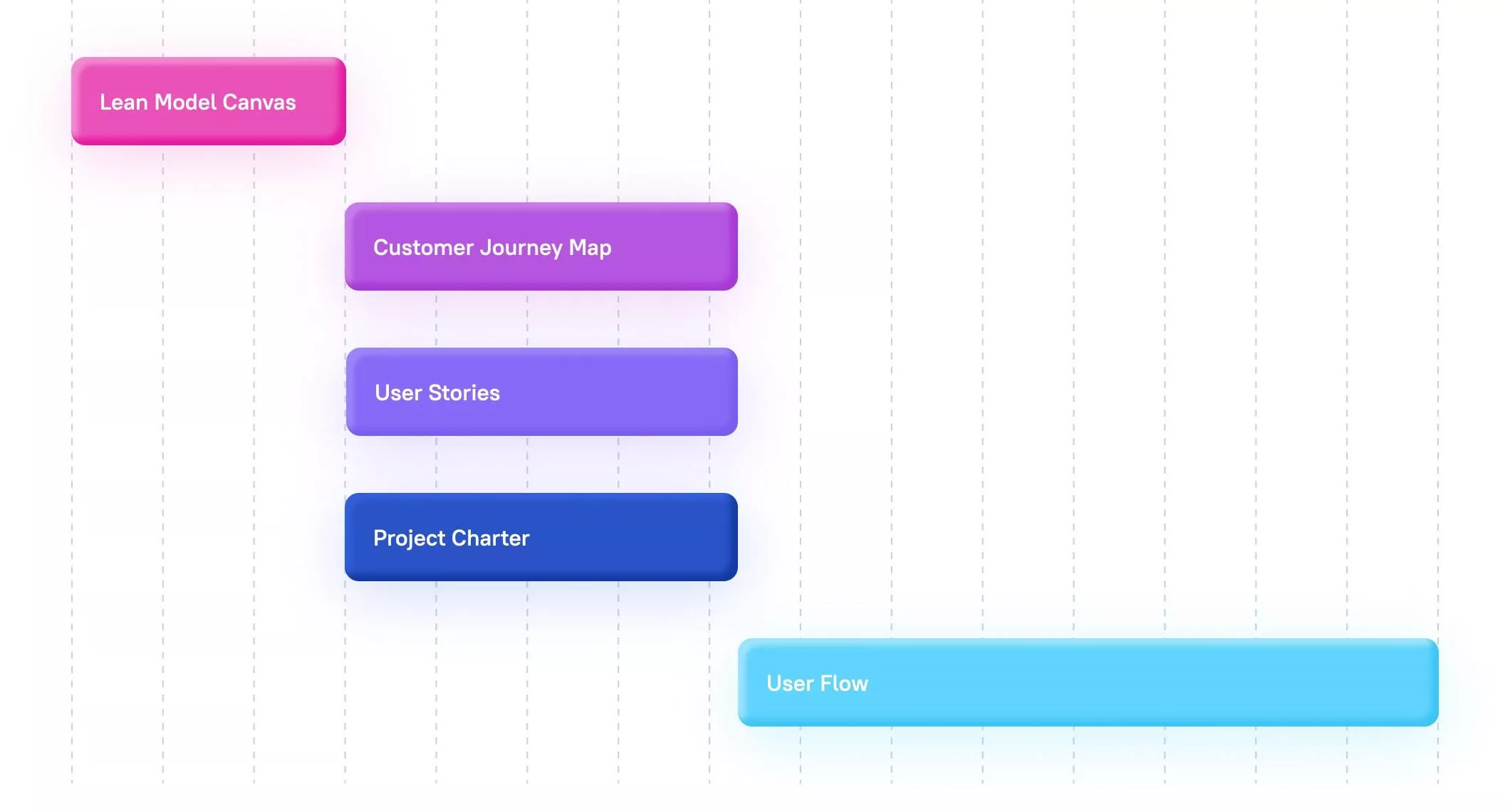
The Discovery Phase is the foundation upon which successful projects are built. It involves a systematic and thorough exploration of various aspects to ensure that the project aligns with your goals and serves the needs of your target audience effectively.
Preparation: During this stage, as a client, you will receive detailed information about the Discovery stage, and it is also the point at which you will sign the contract to initiate the project officially.
During the Preparation of the Discovery Phase, you can contact the Client Happiness Manager.
Lean Model Canvas: The Lean Canvas offers a strategic lens for exploring business opportunities through a problem-solving framework. Collaboratively, we will work with you to pinpoint your customers' needs, concentrate on actionable metrics, and expedite the transition from idea to product, ensuring a streamlined process.
In the Lean Model Canvas stage, we maintain open lines of communication with the client through continuous feedback. All team members participate in these calls, with each specialist addressing questions within their area of expertise.
Audiences: In this stage, we conduct interviews with potential users of our forthcoming product. With this information, we construct protopersonas. A proto persona is a lifelike portrayal of the typical or desired user of the product. It serves to evoke empathy and understand and perceive the end user.
In the Audience stage, the UX designer and BA collaborate.
Customer Journey Map: During this stage, our team is dedicated to constructing the core logic of the upcoming application. We accomplish this by crafting user stories. Additionally, we create descriptions of the forthcoming features and shape the Minimum Viable Product (MVP), which includes a preliminary development estimate.
The Customer Journey Map fosters collaboration among the UX designer, Business Analyst (BA), and Project Manager.
Fixing Results: Result alignment is an integral facet of the Agile process we employ within our company. Its primary objective is to maintain a continuous feedback loop with you. This iterative approach ensures that your vision and the actual development stay in sync.
During the Fixing Result stage, we engage in scheduled calls. We actively seek feedback from the client. The Project Manager, BA, and UX designer are involved.
User Flow: User flow comprises schematic screens (wireframes) of the software solution and the transitions connecting them. We will provide you with a visual representation of the step-by-step actions. This offers a clear roadmap of the user's journey through the application.
In the User Flow stage, the main responsibilities lay on the UX designer.
Documentation and Demo: The final step involves documenting the project and creating a demo for your review. This includes the creation of user stories, a project charter, and providing approximate cost estimates, alongside all the necessary materials. Once these are in place, we are ready to progress to the design stage of the project.
In the Documentation and Demo stage, collaboration occurs among the Client, Project Manager, UX designer, business analyst (BA), and Client Happiness Manager.
Key Activities at the Design Stage of the Project Development Process
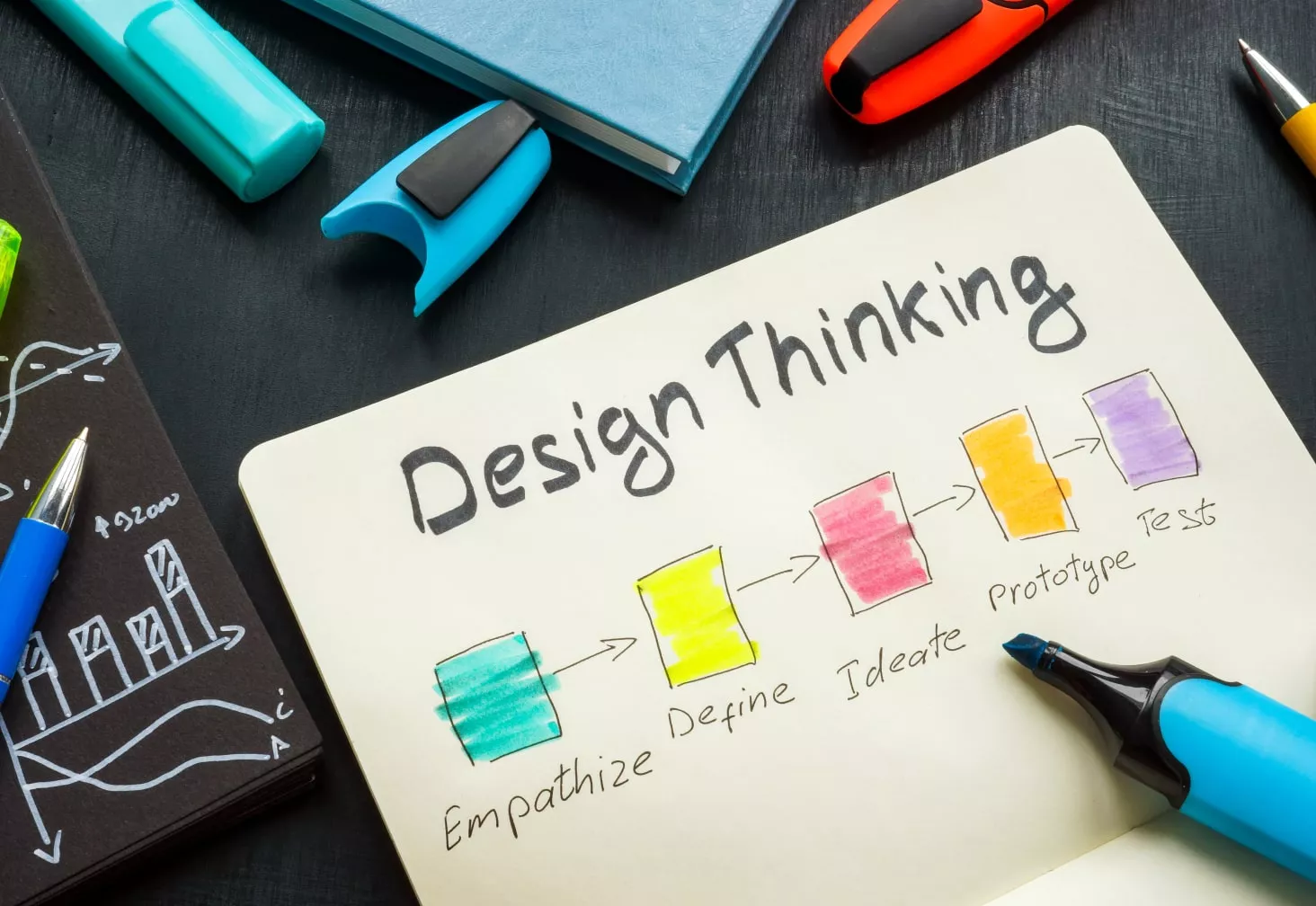
Preparation: During this stage, we ensure that you, as the client, are well-informed about our design phase and allow you to sign the contract or annex.
In the Preparation stage, the contact person is the Client Happiness Manager.
Mood board: Our designer creates a Moodboard to visually represent ideas, conveying emotions, mood, visual style, color schemes, and basic app shapes. This is a critical step in visualizing the future UI design.
During the Mood Board stage, scheduled calls with a duration of 1 to 1.5 hours allow for ongoing feedback exchange with the client. The UI designer is responsible for this phase.
UI Design: Building upon the outcomes of the Discovery Phase and the Mood board, the designer develops a detailed design for all product screens, considering all potential branches of the User flow.
In the UI Design stage, the primary person is the UI Designer.
Technical Analytics: Throughout this stage, each logical component of the design is subject to technical review and validation by our team. They inspect each feature, offering suggestions and recommendations for improvements. This collaborative approach ensures that the project is both user-friendly and highly functional right from the start, helping to save costs by resolving potential issues at the design.
In the Technical Analytics stage, the Developers, CTO, QA, and BA Manager collaborate, and there is an ongoing exchange of feedback from the client.
Interactive Prototype: Once the design is approved, we create an interactive prototype in which all screens are linked to simulate the general user flow of the product. This interactive prototype serves as a valuable tool for demonstrations to your team, investors, and other stakeholders.
In the Interactive Prototype stage, the UI/UX designer is responsible for the prototype.
Reestimation: At this stage, we provide you with a more accurate estimate for the development phase, considering the finalized design and any additional functionality that may have emerged during the design process. This detailed estimate allows you to manage your budget effectively.
In the Reestimation stage, collaboration takes place among the Client, Project Manager, UX Designer, and Client Happiness Manager.
Demo: The final step in the Preparation stage is the demo, which showcases the completed scope of work. After the demo, you will receive all design materials, including the reestimation file, preparing us to transition to the development stage.
In the Demo stage, collaboration unfolds among the Client, Project Manager, UX designer, Client Happiness Manager, and Business Analyst (BA).
Development and Testing Stage Steps
The Development Stage is a crucial phase that involves several key steps to bring your project to life. Here's an overview of the stages within the Development Phase:
Preparation: During this initial stage, we ensure that you, as the client, are well-informed about the development phase, and we proceed with the necessary contract or agreement sign-off.
During the Preparation stage, the Client Happiness Manager serves as the designated contact person.
Planning: Planning is the cornerstone of the entire development process. We work closely with you to set priorities and objectives. Our Project Manager (PM), Business Analyst (BA), and Chief Technology Officer (CTO) collaborate to define the Minimum Viable Product (MVP), create a roadmap, assemble the development team, segment the project into manageable sprints, and establish timelines.
In the Planning stage, we actively seek feedback from the client, with the Project Manager CTO, and BA collaborating.
Development: The development team takes center stage in this phase, working diligently on various sprints. They break down large tasks (stories) into smaller, manageable components, to achieve a functional milestone for each sprint. All development activities are closely monitored by the PM and BA, ensuring that the project progresses according to the predetermined timeline and budget.
During the Development stage, developers and the Project Manager actively contribute to the phase. Consultations with the CTO are also part of the process when necessary.
Quality Assurance (QA): As development progresses, completed tasks are promptly handed over to the QA engineer for thorough testing. This ongoing QA process runs parallel to sprint development, ensuring that issues are identified and addressed promptly. If any bugs are discovered, they are reported, and the stories are returned to the PM for revision. Stories with no issues are forwarded to the BA for final approval. At the end of each sprint, only functionality that has been rigorously tested and approved by the QA and BA is presented to you.
In the Quality Assurance (QA) stage, support is provided by BA. QA and Developers actively contribute to the phase.
Demo: In the Demo stage, the Project Manager, Business Analyst, and Lead Developer showcase the tested and approved functionality to you. This is your opportunity to verify that the demonstrated features align with your requirements and to approve the completed work.
During the Demo stage, we actively seek feedback from the client. Business analyst (BA), Project Manager, and Lead Developer actively contribute to the stage.
Release: The final stage of this development cycle is the release. Once the planned scope of work is completed, or when the achieved functionality aligns with the MVP, the release is initiated with your agreement. Following the release, the bugfix warranty period commences, and ongoing support is provided by the agreed-upon contract.
In the Release stage, we proactively gather feedback from the client. The Project Manager and the Lead Developer actively work on the final stage.
Release
The release phase in the project development process covers production, deployment, and post-production activities, including maintenance and support. In SDLC, this phase involves operations admins and security engineers rather than development engineers.
We handle tasks like software monitoring, security testing, and incident response. In the Secure Software Development Life Cycle (SDLC), our developers are also responsible for security tasks, integrating security with development even in the post-production stage. Additional aspects of the release phase include:
- Verifying the software's performance in the production environment compared to the development environment
- We are gathering feedback from end-users for necessary adjustments
- Performing maintenance and support duties
- Ensuring that the software in production aligns with customer and user requirements from the initial specifications
More Details on Feedback
Responding to feedback involves taking necessary and suitable actions. Based on the feedback, we may need to revise, refactor, or even redesign software. Effective communication, collaboration, and negotiation with the feedback provider or other stakeholders may be essential to reach a consensus or compromise. In all cases, we ensure to follow up and share the outcomes of efforts. This not only signifies dedication to delivering high-quality software but also demonstrates a commitment to addressing feedback seriously.
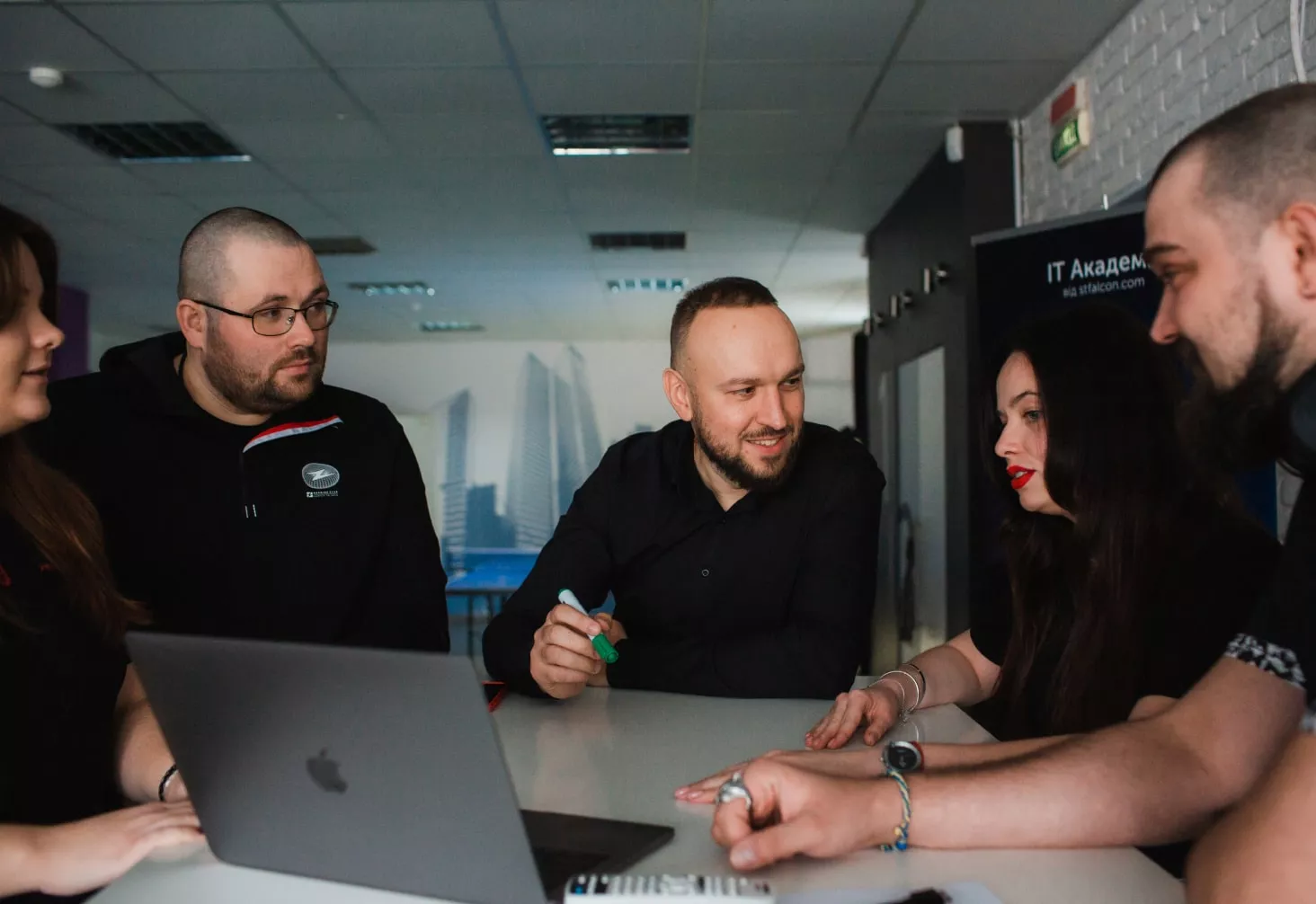
Our Experience
Discovery phase for a real estate company
As we delved into research on the US real estate market, it came to light that engaging in real estate activities necessitated the acquisition of a license that held validity exclusively within a specific city or state. Additionally, we uncovered that this license provided access to comprehensive real estate databases specific to a particular region.
We decided to expand our Minimum Viable Product (MVP) to the Miami market, where our customer secured the necessary license, to gradually extend our reach to the entire US market in subsequent releases.
The project team comprises a Project Manager, Sales Manager, Designer, Backend Developer, iOS Developer, Frontend Developer and QA.
Utilizing the Lean Model Canvas, we gathered insights into the project's structure, functions, budget, and core issues. We identified two main role models, the buyer, and the agent, developing corresponding user journey maps to understand their motivations, goals, needs, fears, and barriers.
To address challenges, proposed solutions include creating a user-friendly interface, offering accessible and cost-effective advertising options, implementing a chat feature for smooth communication, and updating real estate information through official databases. Our research led to a functional prototype, forming the basis for a comprehensive design. Currently, we are actively involved in the app development process.
Design of web app for chronic disease treatments
Stfalcon's mission was to develop a website with an intuitive and user-friendly UX, emphasizing the swift and easy sharing of experiences. Equally important was creating an interface that instills trust in patients.
The platform is designed to address the following key challenges faced by patients:
- Enduring chronic sinusitis and its associated struggles.
- Minimum information about alternative treatment methods, as traditional approaches have waned in effectiveness.
- Providing personalized treatment recommendations, tailored to each patient's unique needs.
- Offering comprehensive insights into the potential side effects of various medications.
- Combating the isolation patients often feel in their battle against this condition.
- Overcoming patients' skepticism toward services that primarily promote medications for financial gain.
At Stfalcon alongside the client, we aim to empower patients with knowledge, support, and a community that understands their journey while fostering trust in the provided solutions.
The team of the project included 6 members: Project Manager, Frontend Developer, System Administrator, Backend Developer, Frontend Developer, and QA.
In the discovery phase, we collaborated with the client to finalize the business model and conducted a thorough analysis of patient issues and competitor landscapes. Monetization strategies were devised to maintain user trust. The client's interaction with the service involves multiple steps, anticipated through the construction of a Customer Journey Map (CJM) during the design phase. This ensures clarity and addresses all user needs.
The designer, in addition to mapping the user's journey, anticipated potential obstacles and proposed effective solutions. The outcome is a functional website characterized by a clear UX, a user-friendly design, and an admin panel for user management and control.
Development of luggage transportation service
The Hump emerges as a Saudi-based startup, driven by a team of enthusiastic brothers who share a fervor for exploration and travel. Stfalcon was entrusted with the responsibility of developing a service solution tailored to frequent air travelers, whether driven by a love for adventure or professional commitments.
The primary objective for this service was to streamline the entire process associated with baggage management, commencing from baggage drop-off at the airport and culminating in the issuance of boarding passes and baggage tags, all to save valuable time for travelers.
Upon the client's request, Stfalcon focused solely on the core functionality to test the idea. The project team included a Designer and a Project Manager.
The MVP version encompasses:
- Order placement functionality
- Luggage tracking capability
- Contact details for Humps and company information
- Bilingual interface (English and Arabic)
- Order submission option to the manager's email
- Email design
- Desktop, tablet, and mobile versions
Stfalcon developed and launched the Hump startup within a month. Operating successfully for six months, the startup has processed over 300 orders. A comprehensive plan for scaling the project is now in place, envisioning features such as baggage tracking, automated status updates, and scheduling appointments for couriers.
Conclusion
The project development process is a multi-faceted journey that demands careful planning, creativity, and adaptability. From the initial idea to the final product launch, it involves a series of stages, including discovery, design, development and testing, and release.
By following best practices we can develop products with increased chances of bringing innovative, ready solutions to the market. Contact us, and our dedicated team, will help you implement your idea into a top-tier product.

 Read the full case study
Read the full case study
 Read the full case study
Read the full case study
 Read the full case study
Read the full case study


